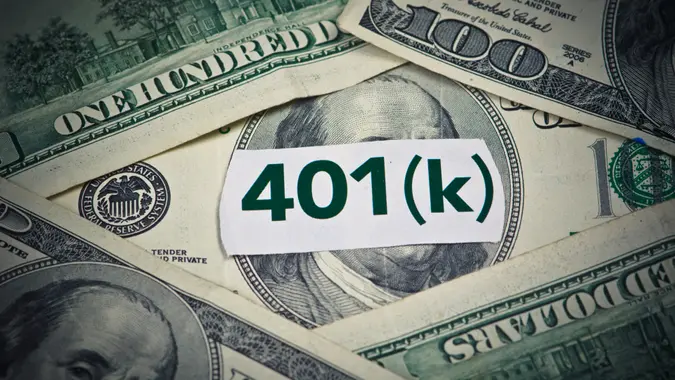Are Micro-Retirements the Key for the Financially Unprepared?

Commitment to Our Readers
GOBankingRates' editorial team is committed to bringing you unbiased reviews and information. We use data-driven methodologies to evaluate financial products and services - our reviews and ratings are not influenced by advertisers. You can read more about our editorial guidelines and our products and services review methodology.

20 Years
Helping You Live Richer

Reviewed
by Experts

Trusted by
Millions of Readers
What if retirement didn’t have to wait until your 60s? Imagine taking shorter breaks from work throughout your life instead of saving up for one big retirement after decades of grind. For many young professionals, the concept of micro-retirements is gaining traction. These short, intentional career breaks offer a way to relax, explore personal goals, and avoid career burnout.
But is this lifestyle shift practical for those who may not feel financially prepared for traditional retirement? And could it end up derailing long-term financial security?
Let’s discuss how micro-retirements could be the ideal solution for the right person who is seeking work-life flexibility.
The Changing Landscape of Work
With the rise of gig work, remote jobs, and flexible schedules, the work model many of us grew up expecting has completely shifted. According to Business.com, more professionals are blending their personal and professional lives, often working irregular hours or staying connected around the clock.
While these changes offer flexibility, they can also lead to serious downsides like burnout, poor work-life balance, and mental health challenges. People in their 30s, 40s, and even 20s are increasingly feeling overworked, which has contributed to the growing popularity of micro-retirements.
This evolving work culture has created an opportunity for workers to rethink their career and financial goals, using micro-retirements as a way to prioritize well-being without completely stepping away from employment.
What Is a Micro-Retirement?
Unlike a traditional retirement, where someone permanently leaves the workforce often at the age of 65 or older, a micro-retirement involves taking a break from work for a specific period — often three months to two years. Think of it as a mid-career pause to rejuvenate, pursue personal projects, or explore other interests.
Micro-retirements are:
- Short-term lasting a few months to a year or two, depending on individual goals
- An intentional pause in your career temporarily where you set plans to return when the break ends
- A way to provide flexibility in your schedule where you might pursue a passion project, travel, spend time with family, or work on your health
Unlike early retirement, micro-retirements don’t require saving millions of dollars upfront. They are smaller financial commitments but still require strategic preparation to avoid long-term financial consequences.
Financial Implications of a Micro-Retirement
Funding a micro-retirement is not just about temporarily walking away from your paycheck and it requires careful planning. Without preparation, it’s easy to undermine your savings or set yourself back financially while also losing precious time during the prime earning years of your career. Here’s how you can plan responsibly.
1. List Out Your Expenses
Budget for your monthly living costs during the break. This should include rent, mortgage, utilities, food, and discretionary spending. For example, if you plan to travel, factor in additional accommodations, airfare, and other expenses.
2. Plan Alternate Sources of Income
While you won’t be working full-time, side gigs, freelancing, or rental income could offset living costs. Some people rent out their homes while traveling, reducing their expenses during a micro-retirement.
3. Save Strategically
To avoid dipping into emergency funds or retirement savings, establish a separate micro-retirement account. Financial tools like a high-yield savings account or money-market account can help grow your short-term savings.
4. Adjust Retirement Contributions
If you’re stepping away from employer-sponsored retirement accounts like a 401(k), consider contributing to an Individual Retirement Account (IRA) during this gap to minimize the hit to your long-term savings goals.
5. Avoid Debt
Using credit cards or loans to fund time off from work could backfire. Aim to have enough saved up to avoid accumulating debt during your break.
A well-crafted financial plan ensures that your micro-retirement is in fact a break and not a burden.
Is a Micro-Retirement Right for You?
While micro-retirements offer many benefits, it also comes with its own set of challenges. Taking time off from work without a solid financial cushion can lead to more stress instead of relief. If you don’t have enough savings or passive income streams, stepping away from your job can cause debt accumulation, gaps in retirement savings, and difficulty re-entering the workforce at the same salary level.
On the other end, saving for a micro-retirement may seem more accessible than saving aggressively to retire early. Some people attempt to fund their micro-retirements by dipping into emergency savings, investments, or credit cards, but this can also create long-term financial instability.
If you’re feeling exhausted and overwhelmed but can’t afford to take months or years off work, you can do things like this instead.
- Take mini career sabbaticals: Instead of a long-term break, consider taking a few weeks or a month off (if possible) to recharge. Some employers offer unpaid leave or sabbaticals, and others allow employees to bank vacation time for extended breaks.
- Job or career change: Sometimes, burnout is a sign that you need a new job, career path, or work environment. If your current role is draining you, exploring less stressful or more fulfilling opportunities can help without requiring an extended break.
- Passive income or side hustles: Building multiple income streams can allow you to cut back hours without quitting entirely. Freelancing, investing, or starting a small online business can give you more financial flexibility over time. Just remember that this will require a lot of time and effort upfront so you’ll need to intentionally maintain a work-life balance.
- Work exchange or low-cost travel options: If your goal is to travel but you can’t afford a full micro-retirement, look into work-exchange programs, house-sitting, or teaching English abroad. These allow you to experience new places while covering basic living expenses.
While micro-retirements work well for people with strong financial foundations, they are still risky for those without savings or passive income. If you’re feeling burnt out, look for alternative ways to create a work-life balance without jeopardizing your financial future. Prioritizing financial stability first can make it easier to take extended breaks down the road without the stress of financial insecurity.
More From GOBankingRates
- Nearly 1 in 3 Americans Hit by a Costly Holiday Scam, Norton Survey Shows -- How To Avoid This
- Here's What the Average Social Security Payment Will Be in Winter 2025
- How Middle-Class Earners Are Quietly Becoming Millionaires -- and How You Can, Too
- The Easiest Way to Score $250 for Things You Already Do
 Written by
Written by  Edited by
Edited by 

























